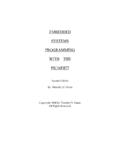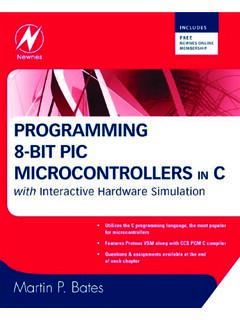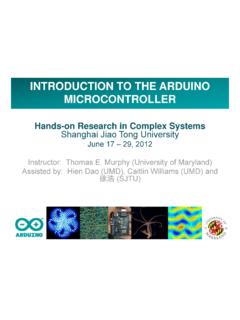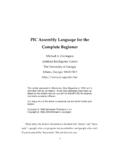Transcription of PIC16F87/88 Data Sheet - Microchip Technology
1 2005 Microchip Technology Sheet18/20/28-Pin Enhanced FlashMicrocontrollers withnanoWatt TechnologyDS30487C-page ii 2005 Microchip Technology contained in this publication regarding deviceapplications and the like is provided only for your convenienceand may be superseded by updates. It is your responsibility toensure that your application meets with your MAKES NO REPRESENTATIONS OR WAR-RANTIES OF ANY KIND WHETHER EXPRESS OR IMPLIED,WRITTEN OR ORAL, STATUTORY OR OTHERWISE,RELATED TO THE INFORMATION, INCLUDING BUT NOTLIMITED TO ITS CONDITION, QUALITY, PERFORMANCE,MERCHANTABILITY OR FITNESS FOR disclaims all liability arising from this information andits use. Use of Microchip s products as critical components inlife support systems is not authorized except with expresswritten approval by Microchip . No licenses are conveyed,implicitly or otherwise, under any Microchip intellectual Microchip name and logo, the Microchip logo, Accuron, dsPIC, KEELOQ, microID, MPLAB, PIC, PICmicro, PICSTART, PRO MATE, PowerSmart, rfPIC, and SmartShunt are registered trademarks of Microchip Technology Incorporated in the and other , FilterLab, Migratable Memory, MXDEV, MXLAB, PICMASTER, SEEVAL, SmartSensor and The Embedded Control Solutions Company are registered trademarks of Microchip Technology Incorporated in the Age, Application Maestro, dsPICDEM, , dsPICworks, ECAN, ECONOMONITOR, FanSense, FlexROM, fuzzyLAB, In-Circuit Serial programming , ICSP, ICEPIC, MPASM, MPLIB, MPLINK, MPSIM, PICkit, PICDEM, , PICLAB, PICtail, PowerCal, PowerInfo, PowerMate, PowerTool, rfLAB, rfPICDEM, Select Mode, Smart Serial.
2 SmartTel and Total Endurance are trademarks of Microchip Technology Incorporated in the and other is a service mark of Microchip Technology Incorporated in the other trademarks mentioned herein are property of their respective companies. 2005, Microchip Technology Incorporated, Printed in the , All Rights Reserved. Printed on recycled the following details of the code protection feature on Microchip devices: Microchip products meet the specification contained in their particular Microchip Data Sheet . Microchip believes that its family of products is one of the most secure families of its kind on the market today, when used in the intended manner and under normal conditions. There are dishonest and possibly illegal methods used to breach the code protection feature. All of these methods, to our knowledge, require using the Microchip products in a manner outside the operating specifications contained in Microchip s Data Sheets.
3 Most likely, the person doing so is engaged in theft of intellectual property. Microchip is willing to work with the customer who is concerned about the integrity of their code. Neither Microchip nor any other semiconductor manufacturer can guarantee the security of their code. Code protection does not mean that we are guaranteeing the product as unbreakable. Code protection is constantly evolving. We at Microchip are committed to continuously improving the code protection features of ourproducts. Attempts to break Microchip s code protection feature may be a violation of the Digital Millennium Copyright Act. If such actsallow unauthorized access to your software or other copyrighted work, you may have a right to sue for relief under that received ISO/TS-16949:2002 quality system certification for its worldwide headquarters, design and wafer fabrication facilities in Chandler and Tempe, Arizona and Mountain View, California in October 2003.
4 The Company s quality system processes and procedures are for its PICmicro 8-bit MCUs, KEELOQ code hopping devices, Serial EEPROMs, microperipherals, nonvolatile memory and analog products. In addition, Microchip s quality system for the design and manufacture of development systems is ISO 9001:2000 certified. 2005 Microchip Technology 1 PIC16F87/88 Low-Power Features: Power-Managed modes:- Primary Run: RC oscillator, 76 A, 1 MHz, 2V- RC_RUN: 7 A, kHz, 2V- SEC_RUN: 9 A, 32 kHz, 2V- Sleep: A, 2V Timer1 Oscillator: A, 32 kHz, 2V Watchdog Timer: A, 2V Two-Speed Oscillator Start-upOscillators: Three Crystal modes:- LP, XT, HS: up to 20 MHz Two External RC modes One External Clock mode:- ECIO: up to 20 MHz Internal oscillator block:- 8 user selectable frequencies: 31 kHz, 125 kHz, 250 kHz, 500 kHz, 1 MHz, 2 MHz, 4 MHz, 8 MHzPeripheral Features: Capture, Compare, PWM (CCP) module:- Capture is 16-bit, max.
5 Resolution is ns- Compare is 16-bit, max. resolution is 200 ns- PWM max. resolution is 10-bit 10-bit, 7-channel Analog-to-Digital Converter Synchronous Serial Port (SSP) with SPI (Master/Slave) and I2C (Slave) Addressable Universal Synchronous Asynchronous Receiver Transmitter (AUSART/SCI) with 9-bit address detection:- RS-232 operation using internal oscillator (no external crystal required) Dual Analog Comparator module:- Programmable on-chip voltage reference- Programmable input multiplexing from device inputs and internal voltage reference- Comparator outputs are externally accessiblePin DiagramSpecial Microcontroller Features: 100,000 erase/write cycles Enhanced Flash program memory typical 1,000,000 typical erase/write cycles EEPROM data memory typical EEPROM Data Retention: > 40 years In-Circuit Serial programming (ICSP )via two pins Processor read/write access to program memory Low-Voltage programming In-Circuit Debugging via two pins Extended Watchdog Timer (WDT):- Programmable period from 1 ms to 268s Wide operating voltage range: to +/RA4/AN4/T0 CKI/RA5/MCLR/VPPVSSRB0/INT/CCP1(1)RB1/SD I/SDARB2/SDO/RX/DTRB3/PGM/CCP1(1)1234567 89181716151413121110 PIC16F88T1 OSIT1 OSO/T1 CKIC2 OUTC1 OUTVREF-RA2/AN2/CVREF/18-Pin PDIP, SOICNote 1.
6 The CCP1 pin is determined by the CCPMX bit inConfiguration Word 1 MemoryData MemoryI/O Pins10-bitA/D (ch)CCP(PWM)AUSART ComparatorsSSPT imers8/16-bitFlash(bytes)# Single-Word InstructionsSRAM (bytes)EEPROM(bytes)PIC16F87716840963682 5616N/A1Y2Y2/1 PIC16F88716840963682561611Y2Y2/118/20/28 -Pin Enhanced Flash MCUs with nanoWatt TechnologyPIC16F87/88DS30487C-page 2 2005 Microchip Technology Diagrams RA1/AN1RA0/AN0RA7/OSC1/CLKIRA6/OSC2/CLKO VDDRB7/PGD/T1 OSIRB6/PGC/T1 OSO/T1 CKIRB5/SS/TX/CKRB4/SCK/SCLRA2/AN2/CVREFR A3/AN3/C1 OUTRA4/T0 CKI/C2 OUTRA5/MCLR/VPPVSSRB0/INT/CCP1(1)RB1/SDI /SDARB2/SDO/RX/DTRB3/PGM/CCP1(1)12345678 9181716151413121110 PIC16F8718-Pin PDIP, SOICRB7/AN6/PGD/T1 OSIRB6/AN5/PGC/T1 OSO/T1 CKIRA7/OSC1/CLKIRA6/OSC2/CLKOVDDRB5/SS/T X/CKRB4/SCK/SCLRB3/PGM/CCP1(1)RB2/SDO/RX /DTRA0/AN0RA1/AN1RA4/AN4/T0 CKI/C2 OUTRA5/MCLR1/VPPVSSRA2/AN2/CVREF/VREF-RA 3/AN3/VREF+/C1 OUTRB0/INT/CCP1(1)RB1/SDI/SDA12345678920 1918171615141312 VDDVSS1011 PIC16F8820-Pin SSOP20-Pin SSOP18-Pin PDIP, SOICRA1/AN1RA0/AN0RA7/OSC1/CLKIRA6/OSC2/ CLKOVDDRB7/AN6/PGD/T1 OSIRB6/AN5/PGC/T1 OSO/T1 CKIRB5/SS/TX/CKRB4/SCK/SCLRA2/AN2/CVREF/ VREF-RA3/AN3/VREF+/C1 OUTRA4/AN4/T0 CKI/C2 OUTRA5/MCLR/VPPVSSRB0/INT/CCP1(1)RB1/SDI /SDARB2/SDO/RX/DTRB3/PGM/CCP1(1)12345678 9181716151413121110 PIC16F88RB7/PGD/T1 OSIRB6/PGC/T1 OSO/T1 CKIRA7/OSC1/CLKIRA6/OSC2/CLKOVDDRB5/SS/T X/CKRB4/SCK/SCLRB3/PGM/CCP1(1)RB2/SDO/RX /DTRA0/AN0RA1/AN1RA4/T0 CKI/C2 OUTRA5/MCLR/VPPVSSRA2/AN2/CVREFRA3/AN3/C 1 OUTRB0/INT/CCP1(1)RB1/SDI/SDA12345678920 1918171615141312 VDDVSS1011 PIC16F87 Note 1:The CCP1 pin is determined by the CCPMX bit in Configuration Word 1 register.
7 2005 Microchip Technology 3 PIC16F87/88 Pin Diagrams (Cont d) 162RA2/AN2/CVREFRA0/AN0RA4/T0 CKI/C2 OUTRA5/MCLR/VPPNCVSSNCRB0/INT/CCP1(1)RB1 /SDI/SDARA3/AN3/C1 OUTRA7/OSC1/CLKIRA6/OSC2/CLKOVDDNCVDDRB7 /PGD/T1 OSIRB6/PGC/T1 OSO/T1 CKIRB5/SS/TX/CKRB4/SCK/SCL7 PIC16F8713654152119201718222826272324251 48109131211 VSSNCNCRA1/AN1RB2/SDO/RX/DTRB3/PGM/CCP1( 1)NCNCNC162RA2/AN2/CVREF/VREF-RA0/AN0RA4 /AN4/T0 CKI/C2 OUTRA5/MCLR/VPPNCVSSNCRB0/INT/CCP1(1)RB1 /SDI/SDARA3/AN3/VREF+/C1 OUTRA7/OSC1/CLKIRA6/OSC2/CLKOVDDNCVDDRB7 /AN6/PGD/T1 OSIRB6/AN5/PGC/T1 OSO/T1 CKIRB5/SS/TX/CKRB4/SCK/SCL7 PIC16F8813654152119201718222826272324251 48109131211 VSSNCNCRA1/AN1RB2/SDO/RX/DTRB3/PGM/CCP1( 1)NCNCNC28-Pin QFN28-Pin QFNNote 1:The CCP1 pin is determined by the CCPMX bit in Configuration Word 1 4 2005 Microchip Technology of Overview .. Organization .. EEPROM and Flash Program Configurations .. Ports.
8 Module .. Module .. Module .. (CCP) Module .. Synchronous Serial Port (SSP) Module .. Addressable Universal Synchronous Asynchronous Receiver Transmitter (AUSART) .. Analog-to-Digital Converter (A/D) Module .. Comparator Comparator Voltage Reference Module .. Special Features of the CPU .. Instruction Set Summary .. Development Electrical Characteristics .. DC and AC Characteristics Graphs and Tables .. Packaging 207 Appendix A: Revision 213 Appendix B: Device 213 Index .. 215 The Microchip Web Site .. 223 Customer Change Notification Service .. 223 Customer Support .. 223 Reader Response .. 224 PIC16F87/88 Product Identification System .. 225TO OUR VALUED CUSTOMERSIt is our intention to provide our valued customers with the best documentation possible to ensure successful use of your Microchipproducts. To this end, we will continue to improve our publications to better suit your needs.
9 Our publications will be refined andenhanced as new volumes and updates are introduced. If you have any questions or comments regarding this publication, please contact the Marketing Communications Department viaE-mail at or fax the Reader Response Form in the back of this data Sheet to (480) 792-4150. Wewelcome your Current Data SheetTo obtain the most up-to-date version of this data Sheet , please register at our Worldwide Web site at: can determine the version of a data Sheet by examining its literature number found on the bottom outside corner of any last character of the literature number is the version number, ( , DS30000A is version A of document DS30000).ErrataAn errata Sheet , describing minor operational differences from the data Sheet and recommended workarounds, may exist for currentdevices. As device/documentation issues become known to us, we will publish an errata Sheet .
10 The errata will specify the revisionof silicon and revision of document to which it determine if an errata Sheet exists for a particular device, please check with one of the following: Microchip s Worldwide Web site; Your local Microchip sales office (see last page)When contacting a sales office, please specify which device, revision of silicon and data Sheet (include literature number) you Notification SystemRegister on our web site at to receive the most current information on all of our products. 2005 Microchip Technology 5 PIC16F87 OVERVIEWThis document contains device specific information forthe operation of the PIC16F87/88 devices. Additionalinformation may be found in the PICmicro Mid-RangeMCU Family Reference Manual (DS33023) which maybe downloaded from the Microchip web site. ThisReference Manual should be considered a comple-mentary document to this data Sheet and is highlyrecommended reading for a better understanding of thedevice architecture and operation of the PIC16F87/88 belongs to the Mid-Range family ofthe PICmicro devices.



















